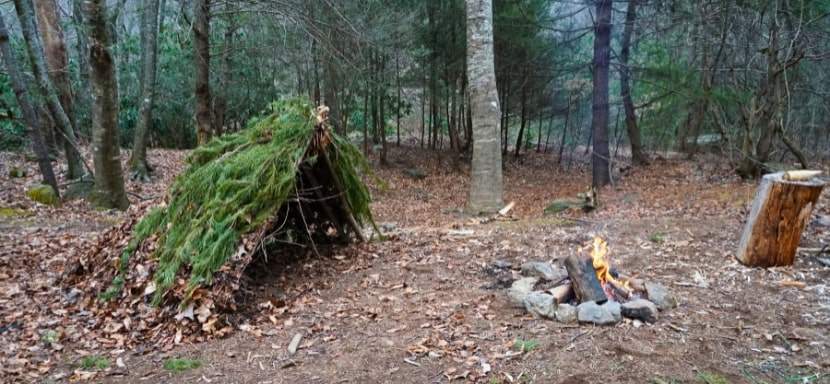How to Build a Survival Shelter in the Wild

Building a Shelter for Survival Situations
Your first line of defense in a survival situation is a sturdy shelter. Learn techniques for constructing a reliable refuge in the wild and safeguarding yourself against the elements.
Knowing how to build a survival shelter can be the key to staying safe and warm in an unexpected situation in the wild. Whether lost, caught in a sudden storm, or simply exploring remote areas, a well-constructed shelter provides vital protection from the elements.
This guide will walk you through everything you need to know about constructing different types of shelters, from the simplest lean-to to more complex debris huts.
Key Takeaways
- Choose the Right Location: Select a safe, elevated spot away from potential hazards, with natural windbreaks and proximity to essential resources like water.
- Utilize Available Materials: Use branches, leaves, and other natural materials to build a sturdy and insulating structure, adapting your shelter type to the environment.
- Ensure Proper Insulation: Cover your shelter with ample debris or a tarp to retain heat and protect against the elements, prioritizing warmth and dryness.
Shelter Building is a Top Three Survival Skill
In any survival situation, the three most critical priorities are finding or building a shelter, securing a reliable water source, and starting a fire. These essentials form the foundation of survival. A shelter provides immediate protection from the elements and wildlife, creating a safe space to rest and maintain body heat.
Meanwhile, finding a water source is crucial for hydration and maintaining bodily functions, as dehydration can occur quickly. Lastly, knowing how to start a fire is essential for warmth, cooking, and signaling for help.
Mastering these three survival tips can significantly enhance your chances of enduring and overcoming challenging environments.
What is a Survival Shelter?
A survival shelter is a makeshift structure built to protect individuals from environmental elements such as rain, wind, snow, and extreme temperatures when stranded or in the wilderness. It is a critical component of survival strategy, providing safety, warmth, and a psychological sense of security.
These shelters range from simple lean-tos made with branches and leaves to more sophisticated designs using tarps or emergency blankets. The primary purpose of a survival shelter is to conserve body heat, shield it from weather, and offer a barrier against wildlife and insects, thereby increasing the chances of survival in emergencies.
10 Quick Tips for Building a Survival Shelter
Building a survival shelter is crucial for staying safe in the wilderness. With the proper techniques, you can create a secure and comfortable refuge. Here are ten quick tips to help you build an adequate survival shelter.
- Choose an Elevated Spot: Avoid water accumulation and cold air pockets.
- Utilize Natural Windbreaks: Use rocks or dense trees to block wind.
- Insulate with Natural Materials: Cover your shelter with leaves, grass, and moss to retain heat.
- Secure the Foundation: Ensure the base is stable and supportive.
- Keep the Entrance Small: Retain warmth and keep out larger wildlife.
- Use Sturdy Support Structures: Select strong branches or rocks for the frame.
- Waterproof the Roof: Layer leaves and branches to create a barrier.
- Reinforce with Cordage: Use ropes or vines to tie and secure components.
- Maintain Proper Ventilation: Prevent condensation and maintain air quality.
- Regularly Check and Maintain: Inspect for damage and reinforce as needed.
The Importance of Building a Survival Shelter
When faced with harsh conditions in the wilderness, a well-constructed survival shelter becomes your primary defense against the elements.
The importance of adequate shelter cannot be overstated, as it is critical to your overall survival strategy. Here’s why building a survival shelter is essential:
- Protection from Weather: A shelter protects against adverse weather conditions such as rain, snow, wind, and extreme temperatures. Exposure to these elements can quickly lead to hypothermia or heatstroke, making it crucial to have a protective barrier.
- Insulation: Proper insulation is critical to retaining body heat, especially in cold environments. Using natural materials like leaves, grass, and moss, you can create an insulating layer that helps maintain your body temperature and prevents the onset of hypothermia.
- Safety from Wildlife: You may encounter potentially dangerous animals in the wild. A shelter acts as a barrier, deterring animals from approaching and providing a safer resting area. It also helps keep insects and other small creatures at bay.
- Psychological Comfort: Having a shelter can significantly boost your morale. It provides security and stability, giving you a base of operations to manage other survival tasks, such as finding food and water. This psychological comfort can be crucial in maintaining a positive mindset, vital for survival.
Materials and Tools for Building Shelters
A survival shelter requires natural materials and basic tools for stability and protection. Here are the key materials and tools you’ll need:
Natural Materials:
- Branches and Logs: Provide structure and support.
- Leaves, Grass, and Moss: Offer insulation and fill gaps.
- Rocks: Secure materials and create windbreaks.
Tools:
- Knife or Multi-Tool: For cutting branches and rope.
- Cordage: Essential for tying and securing components.
- Tarp or Emergency Blanket: For quick shelter and extra protection.
Did You Know?
Snow is an excellent insulating material when building a survival shelter. Constructing a quinzee or snow cave can provide remarkable warmth in cold environments. The compacted snow traps body heat, creating an insulated space that can be significantly warmer than the outside air, sometimes by as much as 50 degrees Fahrenheit!
Types of Survival Shelters
There are several types of survival shelters, each suited for different environments and materials available.
1. Debris Hut
Structure: A-frame made from branches, covered with leaves and debris.
Best for: Forested areas with ample natural materials.
Step-by-Step Guide: Building a Debris Hut
- Select Your Location: Choose an elevated area free from hazards.
- Construct the Ridge Pole: Find a sturdy branch to act as the primary support.
- Build the Frame: Lean shorter branches against the ridge pole to form an A-frame.
- Insulate: Cover the frame with leaves, pine needles, and other natural debris.
- Seal the Shelter: Fill in gaps with more debris to trap heat.
- Create the Entrance: Ensure it’s small to retain warmth but accessible.
2. Lean-To Shelter
Structure: Simple one-sided shelter leaning against a supportive structure.
Best for: Areas with a nearby supportive structure like a large rock or tree.
Step-by-Step Guide: Building a Lean-To Shelter
- Select Your Location: Choose a spot with natural windbreaks, like a large tree or rock, and ensure the ground is flat and dry.
- Find a Support Structure: A sturdy tree or large rock anchors the shelter’s spine.
- Construct the Spine: At an angle, lean a long, strong branch (ridge pole) against the support structure.
- Build the Frame: Lean shorter branches against the spine on one side to create the slanted roof.
- Cover the Frame: Layer leaves, grass, and other natural materials over the branches to create a waterproof barrier.
- Insulate the Roof: Add more leaves and debris for additional insulation.
- Secure the Bottom: Place rocks or logs at the base of the lean-to to keep materials in place and provide stability.
- Create the Entrance: Ensure the opening faces away from the wind and is large enough for entry but small enough to retain heat.
- Add Ground Insulation: For ground insulation, lay a thick layer of leaves, grass, or pine needles inside the shelter.
- Reinforce as Needed: Regularly check the structure for stability and add more materials to maintain warmth and protection.
3. Tarp Shelter
Structure: Versatile shelter using a tarp and rope.
Best for: Open areas or when you have limited natural resources.
Step-by-Step Guide: Building a Tarp Shelter
- Select Your Location: Choose an elevated area free from hazards with natural windbreaks and flat ground.
- Find Anchor Points: Locate two sturdy anchor points like trees or large rocks to secure your tarp.
- Secure the Ridgeline: Tie a rope or cord between the two anchor points to create a ridgeline.
- Drape the Tarp: Drape the tarp over the ridgeline to form an inverted V shape.
- Secure the Corners: Anchor the tarp’s corners to the ground using stakes, rocks, or logs to keep it in place.
- Tighten the Tarp: Ensure the tarp is taut to prevent water pooling and wind flapping. Adjust as necessary for a snug fit.
- Create the Entrance: Make sure one side of the tarp has an accessible entrance, preferably facing away from the wind.
- Add Ground Insulation: Lay down leaves, grass, or a sleeping pad inside the shelter for ground insulation.
- Check Stability: Regularly check the tarp and anchor points to ensure they remain secure, especially in windy conditions.
- Reinforce if Needed: Add additional ties or weights if the tarp begins to sag or weather conditions worsen.
Maintaining Your Shelter
Proper maintenance is crucial to ensure your shelter continues to provide adequate protection and comfort. Regular upkeep helps preserve the integrity of the structure and enhances its effectiveness.
- Regular Checks: Verify that the shelter remains stable and dry.
- Reinforce Insulation: Add extra debris for warmth, especially during colder weather.
- Repair Damages: Promptly fix any damage caused by wind, wildlife, or other factors.
Bad Places to Build a Survival Shelter
Choosing the wrong location for your shelter can jeopardize your safety and comfort. Avoid these areas to ensure your survival shelter is adequate and secure.
- Low-Lying Areas: These are prone to flooding and colder temperatures.
- Animal Trails: Wildlife paths can lead to dangerous encounters with animals.
- Under Dead Trees: Also known as “widowmakers,” these can fall and cause serious injury.
- Near Insect Nests: Avoid areas with high insect activity to prevent bites and stings.
- Exposed Ridges: These locations are vulnerable to high winds and storms.
- Anywhere it is Damp: Damp areas can lead to discomfort and increase the risk of hypothermia.
- In the Bottom of Narrow Valleys: Cold air collects here at night, making it much colder.
Additional Tips for Building a Survival Shelter
These additional tips can enhance your efficiency and overall success when constructing your survival shelter, ensuring a safer and more comfortable refuge.
- Stay Calm: Maintain a clear and focused mind while building your shelter. Panicking can lead to mistakes and inefficient use of time and resources.
- Conserve Energy: Use efficient building techniques to save energy. Avoid overexertion by planning your actions and using available materials wisely.
- Hydration: Stay hydrated throughout the process. Dehydration can impair your judgment and physical performance. Always be aware of your water sources and ensure you have enough to drink.
Don’t Forget Your Bed
Your shelter is incomplete until you have made a bed to lie in. A well-constructed bed can significantly improve your comfort and warmth during the night. Dry leaves, grass, or pine needles work well as bedding materials.
To provide adequate insulation from the cold ground, make your bed slightly larger than your body and at least eight inches thick.
Snuggling into it creates a cozy barrier that helps retain body heat, ensuring you are ready for an unexpected night out. A good bed is essential for restful sleep and maintaining energy and morale in survival situations.
FAQs About Building Shelters
What is the best type of shelter for extreme cold?
A debris hut is excellent for extreme cold due to its insulating properties.
How can I make my shelter more comfortable?
Add a layer of leaves or grass inside for bedding, and use a tarp or emergency blanket for added insulation.
How do I ensure my shelter is waterproof?
Ensure the roof is well-covered with debris, and consider using a tarp if available.
What should I do if I can't find enough materials?
Use the available resources. For example, use rocks for walls or a tarp to expedite the process.
Can I build a shelter without tools?
You can construct a basic shelter without tools using natural materials like branches and leaves.
How long can a survival shelter last?
Depending on maintenance and weather conditions, a well-constructed shelter can last several days to weeks.
Final Thoughts About Building an Emergency Shelter
Learning how to build a survival shelter is vital for anyone venturing into the wilderness. By understanding the types of shelters, the materials needed, and the proper construction techniques, you can ensure your safety and comfort in an emergency.
Remember, the key to survival is preparation and adaptability. Equip yourself with knowledge, practice these skills, and you’ll be ready to face any challenge the wild throws your way.
Life-Saving Shelters: Famous Rescue Stories in History
Throughout history, there have been remarkable stories of survival where individuals have relied on their ingenuity and resourcefulness to build shelters in the wilderness. These rescues highlight the importance of survival skills and the human spirit’s resilience in adversity.
- Alexander Selkirk (1704-1709): The inspiration for Robinson Crusoe, Selkirk survived on an uninhabited island in the South Pacific by constructing shelters from local resources until his rescue after four years.
- Douglas Mawson (1912-1913): Antarctic explorer Douglas Mawson built snow shelters to survive after losing his team members and supplies during an expedition. He endured for over a month before reaching safety.
- Juliane Koepcke (1971): After her plane crashed in the Peruvian jungle, 17-year-old Juliane Koepcke survived for 11 days by building makeshift shelters from natural materials before being rescued.
- Eduardo Strauch (1972): One of the survivors of the Andes flight disaster, Strauch and others built makeshift shelters from the wreckage and snow to survive 72 days in the mountains before being rescued.
- Tom Neale (1952-1977): Neale voluntarily lived alone on Suwarrow Atoll in the South Pacific, building and maintaining survival shelters over 16 years, relying on his skills until passing ships periodically visited him.
- Yossi Ghinsberg (1981): Lost in the Amazon rainforest, Ghinsberg survived three weeks by constructing shelters from bamboo and leaves, using survival skills he learned before the expedition until he was rescued.
- Steven Callahan (1982): After his boat sank in the Atlantic Ocean, Callahan survived 76 days adrift in a life raft. He constructed makeshift shelters from parts of his raft to protect himself from the sun and storms.
- Tami Oldham Ashcraft (1983): After her boat was damaged in a hurricane in the Pacific Ocean, Ashcraft survived 41 days by building makeshift shelters on the remains of her vessel until she was rescued by a passing ship.
- Aron Ralston (2003): Trapped by a boulder in Utah’s Bluejohn Canyon, Ralston survived by constructing a small shelter in the canyon for five days before amputating his arm and hiking to safety.
- Ricky Megee (2006): Lost in the Australian Outback, Megee built several shelters from branches and leaves, surviving for 71 days on a diet of insects, frogs, and plants before being found by farmers.
More Survival Tips and Advice

How to Protect Yourself From Insects in the Wild
There’s nothing like being out in the wild—birdsong echoing through the trees, the fresh scent of earth, and a deep sense of peace that makes you think, “Ah, this is what life is about.” But then comes the buzzing. Mosquitoes, ticks, and flies swoop in like uninvited...

How to Identify Poisonous Plants
Exploring the great outdoors can be incredibly refreshing, offering a chance to reconnect with nature and unwind from daily stresses. However, it also comes with its fair share of risks. Chief among them? Poisonous plants. These hidden hazards can turn a peaceful...

How to Use the Sun to Tell Time
Using the sun to tell time sounds like a Robinson Crusoe novel. Imagine being stranded on a desert island with no phone, clock, or sundial. You'd still have one incredibly reliable resource: the sun. It’s been doing its thing for billions of years, and by the looks of...

How to Purify Water Using Boiling
When you're miles away from civilization, lost in the wilderness, or don't trust what's coming out of your tap, the idea of pure, clean drinking water starts to sound like a mythical oasis. Maybe it's all those survival shows you've binged, but suddenly, you're eyeing...

How to Build a Faraday Cage
Have you ever had one of those moments when your phone seems to be on its own personal field trip through Wi-Fi signals, Bluetooth, and all kinds of electromagnetic noise? Well, I have. The endless hum of invisible waves flying through the air makes you wonder—how can...
More Survival Scenarios

How to Survive a Layoff
When the Floor Falls Out: The Reality of a Layoff Layoffs feel personal—even when they're not. One day, you're responding to Slack messages and forwarding emails. Next, you're staring at your monitor as it logs you out... for good. Whether it's a restructuring, a...

How to Survive a Drug Test
The Cup, The Room, The Truth I never imagined I’d be so emotionally invested in a paper cup. But there I was, standing under the fluorescent hum of a strip-mall clinic, trying to recall the last time I ate a poppy seed bagel. That’s the thing about drug tests—they...

How to Survive an Interrogation
If you've ever been caught in the crosshairs of an overly enthusiastic mall cop or stared down by someone in a uniform with a clipboard and a glare, you’ve felt it — the chilly fingers of interrogation anxiety. And while most of us imagine interrogation scenes as...

How to Survive a Nightclub Shooting
Nightclubs pulse with life—lights flashing, music pounding, bodies packed tight on the dance floor. It’s a place to escape, feel the rhythm, and lose yourself in the crowd. But that same energy can turn deadly in seconds, transforming a night of fun into one of the...

How to Survive a Bachelor Party
A bachelor party is a delicate mix of celebration, chaos, and questionable decision-making, wrapped in the noble intention of sending the groom off into married life with a night he’ll (hopefully) remember. It’s a ritual as old as time—well, as old as men deciding...

How to Survive Your First Time at the Gym
Walking into a gym for the first time can feel like stepping into an alien world. The machines hum with purpose, the regulars move confidently, and you’re left standing there, clutching your water bottle, wondering whether you’re in the right place—or on the right...

How to Survive a Worldwide Communications Breakdown
Imagine waking up to silence. Your phone doesn’t buzz, your email won’t load, and even your local radio station crackles with static. A worldwide communications breakdown has hit. What next? For many, this doomsday scenario may sound like the opening lines of a...

How to Survive a Flash Flood While Driving
Surviving a flash flood while driving requires quick thinking, calmness, and a solid plan to ensure your safety. Preparation can make all the difference between a close call and a catastrophe in emergencies like this. This guide provides practical advice to protect...

How to Build an Emergency Kit
Emergencies don’t knock politely at the door. They barge in, uninvited, like a distant relative with a penchant for drama, turning your world upside down without warning. Whether it’s a power outage, a natural disaster, or an unexpected evacuation, the key to staying...

How to Protect Yourself From Insects in the Wild
There’s nothing like being out in the wild—birdsong echoing through the trees, the fresh scent of earth, and a deep sense of peace that makes you think, “Ah, this is what life is about.” But then comes the buzzing. Mosquitoes, ticks, and flies swoop in like uninvited...
